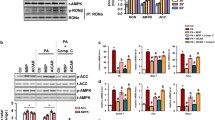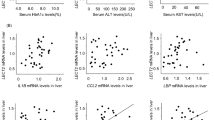Abstract
Recruitment of monocytes in the liver is a key pathogenic feature of hepatic inflammation in nonalcoholic steatohepatitis (NASH), but the mechanisms involved are poorly understood. Here, we studied migration of human monocytes in response to supernatants obtained from liver cells after inducing lipoapoptosis with saturated free fatty acids (FFA). Lipoapoptotic supernatants stimulated monocyte migration with the magnitude similar to a monocyte chemoattractant protein, CCL2 (MCP-1). Inhibition of c-Jun NH2-terminal kinase (JNK) in liver cells with SP600125 blocked migration of monocytes in a dose-dependent manner, indicating that JNK stimulates release of chemoattractants in lipoapoptosis. Notably, treatment of supernatants with Apyrase to remove ATP potently inhibited migration of THP-1 monocytes and partially blocked migration of primary human monocytes. Inhibition of the CCL2 receptor (CCR2) on THP-1 monocytes with RS102895, a specific CCR2 inhibitor, did not block migration induced by lipoapoptotic supernatants. Consistent with these findings, lipoapoptosis stimulated pathophysiological extracellular ATP (eATP) release that increased supernatant eATP concentration from 5 to ~60 nM. Importantly, inhibition of Panx1 expression in liver cells with short hairpin RNA (shRNA) decreased supernatant eATP concentration and inhibited monocyte migration, indicating that monocyte migration is mediated in part by Panx1-dependent eATP release. Moreover, JNK inhibition decreased supernatant eATP concentration and inhibited Pannexin1 activation, as determined by YoPro-1 uptake in liver cells in a dose-dependent manner. These results suggest that JNK regulates activation of Panx1 channels, and provide evidence that Pannexin1-dependent pathophysiological eATP release in lipoapoptosis is capable of stimulating migration of human monocytes, and may participate in the recruitment of monocytes in chronic liver injury induced by saturated FFA.








Similar content being viewed by others
References
Alkhouri N, Carter-Kent C, Feldstein AE (2011) Apoptosis in nonalcoholic fatty liver disease: diagnostic and therapeutic implications. Expert Rev Gastroenterol Hepatol 5(2):201–212
Malhi H, Gores GJ (2008) Molecular mechanisms of lipotoxicity in nonalcoholic fatty liver disease. Semin Liver Dis 28(4):360–369
de Almeida IT et al (2002) Plasma total and free fatty acids composition in human non-alcoholic steatohepatitis. Clin Nutr 21(3):219–223
Malhi H et al (2006) Free fatty acids induce JNK-dependent hepatocyte lipoapoptosis. J Biol Chem 281(17):12093–12101
Wei Y et al (2006) Saturated fatty acids induce endoplasmic reticulum stress and apoptosis independently of ceramide in liver cells. Am J Physiol Endocrinol Metab 291(2):E275–E281
Czaja MJ (2010) JNK regulation of hepatic manifestations of the metabolic syndrome. Trends Endocrinol Metab 21(12):707–713
Seki E, Brenner DA, Karin M (2012) A liver full of JNK: signaling in regulation of cell function and disease pathogenesis, and clinical approaches. Gastroenterology 143(2):307–320
Miura K et al (2012) Hepatic recruitment of macrophages promotes nonalcoholic steatohepatitis through CCR2. Am J Physiol Gastrointest Liver Physiol 302(11):G1310–G1321
Seki E et al (2009) CCR2 promotes hepatic fibrosis in mice. Hepatology 50(1):185–197
Zimmermann HW et al (2010) Functional contribution of elevated circulating and hepatic non-classical CD14CD16 monocytes to inflammation and human liver fibrosis. PLoS One 5(6), e11049
Karlmark KR et al (2009) Hepatic recruitment of the inflammatory Gr1+ monocyte subset upon liver injury promotes hepatic fibrosis. Hepatology 50(1):261–274
Miura K et al (2010) Role of toll-like receptors and their downstream molecules in the development of nonalcoholic fatty liver disease. Gastroenterol Res Pract 2010:362847
Obstfeld AE et al (2010) C-C chemokine receptor 2 (CCR2) regulates the hepatic recruitment of myeloid cells that promote obesity-induced hepatic steatosis. Diabetes 59(4):916–925
Haukeland JW et al (2006) Systemic inflammation in nonalcoholic fatty liver disease is characterized by elevated levels of CCL2. J Hepatol 44(6):1167–1174
Elliott MR et al (2009) Nucleotides released by apoptotic cells act as a find-me signal to promote phagocytic clearance. Nature 461(7261):282–286
Chekeni FB et al (2010) Pannexin 1 channels mediate ‘find-me’ signal release and membrane permeability during apoptosis. Nature 467(7317):863–867
Di Virgilio F (2007) Liaisons dangereuses: P2X(7) and the inflammasome. Trends Pharmacol Sci 28(9):465–472
Gudipaty L et al (2003) Essential role for Ca2+ in regulation of IL-1beta secretion by P2X7 nucleotide receptor in monocytes, macrophages, and HEK-293 cells. Am J Physiol Cell Physiol 285(2):C286–C299
Xiao F et al (2012) Pannexin1 contributes to pathophysiological ATP release in lipoapoptosis induced by saturated free fatty acids in liver cells. Am J Physiol Cell Physiol 303(10):C1034–C1044
Iglesias R et al (2008) P2X7 receptor-Pannexin1 complex: pharmacology and signaling. Am J Physiol Cell Physiol 295(3):C752–C760
Locovei S, Bao L, Dahl G (2006) Pannexin 1 in erythrocytes: function without a gap. Proc Natl Acad Sci U S A 103(20):7655–7659
Ransford GA et al (2009) Pannexin 1 contributes to ATP release in airway epithelia. Am J Respir Cell Mol Biol 41(5):525–534
Seminario-Vidal L et al (2011) Rho signaling regulates pannexin 1-mediated ATP release from airway epithelia. J Biol Chem 286(30):26277–26286
Silverman WR et al (2009) The pannexin 1 channel activates the inflammasome in neurons and astrocytes. J Biol Chem 284(27):18143–18151
Penuela S, Gehi R, Laird DW (2013) The biochemistry and function of pannexin channels. Biochim Biophys Acta 1828(1):15–22
Thompson RJ et al (2008) Activation of pannexin-1 hemichannels augments aberrant bursting in the hippocampus. Science 322(5907):1555–1559
Thompson RJ, Zhou N, MacVicar BA (2006) Ischemia opens neuronal gap junction hemichannels. Science 312(5775):924–927
Nishida M et al (2008) P2Y6 receptor-Galpha12/13 signalling in cardiomyocytes triggers pressure overload-induced cardiac fibrosis. EMBO J 27(23):3104–3115
Qu Y et al (2011) Pannexin-1 is required for ATP release during apoptosis but not for inflammasome activation. J Immunol 186(11):6553–6561
Kakisaka K et al (2012) Mechanisms of lysophosphatidylcholine-induced hepatocyte lipoapoptosis. Am J Physiol Gastrointest Liver Physiol 302(1):G77–G84
Fuss IJ et al (2009) Isolation of whole mononuclear cells from peripheral blood and cord blood. Curr Protoc Immunol. Chapter 7: p. Unit7 1
Belfort R et al (2006) A placebo-controlled trial of pioglitazone in subjects with nonalcoholic steatohepatitis. N Engl J Med 355(22):2297–2307
Nehra V et al (2001) Nutritional and metabolic considerations in the etiology of nonalcoholic steatohepatitis. Dig Dis Sci 46(11):2347–2352
Sandilos JK et al (2012) Pannexin 1, an ATP release channel, is activated by caspase cleavage of its pore-associated C-terminal autoinhibitory region. J Biol Chem 287(14):11303–11311
Braunersreuther V et al (2012) Role of cytokines and chemokines in non-alcoholic fatty liver disease. World J Gastroenterol 18(8):727–735
Marra F, Tacke F (2014) Roles for chemokines in liver disease. Gastroenterology 147(3):577–594, e1
Higgins KR, Kovacevic W, Stokes L (2014) Nucleotides regulate secretion of the inflammatory chemokine CCL2 from human macrophages and monocytes. Mediat Inflamm 2014:293925
Ben Yebdri F et al (2009) Concomitant activation of P2Y(2) and P2Y(6) receptors on monocytes is required for TLR1/2-induced neutrophil migration by regulating IL-8 secretion. Eur J Immunol 39(10):2885–2894
Kishimoto K et al (2006) Olopatadine suppresses the migration of THP-1 monocytes induced by S100A12 protein. Mediat Inflamm 2006(1):42726
Mandrekar P et al (2011) An essential role for monocyte chemoattractant protein-1 in alcoholic liver injury: regulation of proinflammatory cytokines and hepatic steatosis in mice. Hepatology 54(6):2185–2197
Chekeni FB, Ravichandran KS (2011) The role of nucleotides in apoptotic cell clearance: implications for disease pathogenesis. J Mol Med (Berl) 89(1):13–22
Ravichandran KS (2011) Beginnings of a good apoptotic meal: the find-me and eat-me signaling pathways. Immunity 35(4):445–455
Baeck C et al (2012) Pharmacological inhibition of the chemokine CCL2 (MCP-1) diminishes liver macrophage infiltration and steatohepatitis in chronic hepatic injury. Gut 61(3):416–426
Feldstein AE et al (2003) Hepatocyte apoptosis and fas expression are prominent features of human nonalcoholic steatohepatitis. Gastroenterology 125(2):437–443
Sarma NJ et al (2014) Hepatitis C virus-induced changes in microRNA 107 (miRNA-107) and miRNA-449a modulate CCL2 by targeting the interleukin-6 receptor complex in hepatitis. J Virol 88(7):3733–3743
Holt AP et al (2009) Liver myofibroblasts regulate infiltration and positioning of lymphocytes in human liver. Gastroenterology 136(2):705–714
Hoque R et al (2012) P2X7 receptor-mediated purinergic signaling promotes liver injury in acetaminophen hepatotoxicity in mice. Am J Physiol Gastrointest Liver Physiol 302(10):G1171–G1179
Dolovcak S et al (2011) Evidence for sustained ATP release from liver cells that is not mediated by vesicular exocytosis. Purinergic Signal 7(4):435–446
Maes M et al (2014) Connexin and pannexin (hemi)channels in the liver. Front Physiol 4:405
Lohman AW, Isakson BE (2014) Differentiating connexin hemichannels and pannexin channels in cellular ATP release. FEBS Lett 588(8):1379–1388
Steinberg TH et al (1987) ATP4- permeabilizes the plasma membrane of mouse macrophages to fluorescent dyes. J Biol Chem 262(18):8884–8888
Pelegrin P, Surprenant A (2009) The P2X(7) receptor-pannexin connection to dye uptake and IL-1beta release. Purinergic Signal 5(2):129–137
Levesque SA et al (2010) NTPDase1 governs P2X7-dependent functions in murine macrophages. Eur J Immunol 40(5):1473–1485
Emmett DS et al (2008) Characterization of ionotrophic purinergic receptors in hepatocytes. Hepatology 47(2):698–705
Cankurtaran-Sayar S, Sayar K, Ugur M (2009) P2X7 receptor activates multiple selective dye-permeation pathways in RAW 264.7 and human embryonic kidney 293 cells. Mol Pharmacol 76(6):1323–1332
Blum AE et al (2008) Rho-family GTPases modulate Ca(2+) -dependent ATP release from astrocytes. Am J Physiol Cell Physiol 295(1):C231–C241
Eltzschig HK, Sitkovsky MV, Robson SC (2012) Purinergic signaling during inflammation. N Engl J Med 367(24):2322–2333
Vaughn BP, Robson SC, Burnstock G (2012) Pathological roles of purinergic signaling in the liver. J Hepatol 57(4):916–920
Grants
Dr Xiao and Dr. Kilic were supported in part by the National Institutes of Health (NIH) grants R37 DK-46082 (PI, JG Fitz), R01 DK-41876 (PI, GJ Gores). Dr. Davis was supported by NIH grants P50-AR055503 (PI, C Mohan), R01DK081872 (PI, C Mohan), the Alliance for Lupus Research, and the Rheumatic Diseases Division Biomarker Core.
Conflicts of interest
No conflicts of interest, financial or otherwise, are declared by the authors.
Author contributions
FX, SLW, LD, and SFB performed the experiments. GJG assisted in manuscript preparation. GK designed the experiments; GK, FX, and LD prepared and approved the manuscript for submission.
Author information
Authors and Affiliations
Corresponding author
Electronic supplementary material
Rights and permissions
About this article
Cite this article
Xiao, F., Waldrop, S.L., Bronk, S.F. et al. Lipoapoptosis induced by saturated free fatty acids stimulates monocyte migration: a novel role for Pannexin1 in liver cells. Purinergic Signalling 11, 347–359 (2015). https://doi.org/10.1007/s11302-015-9456-5
Received:
Accepted:
Published:
Issue Date:
DOI: https://doi.org/10.1007/s11302-015-9456-5




